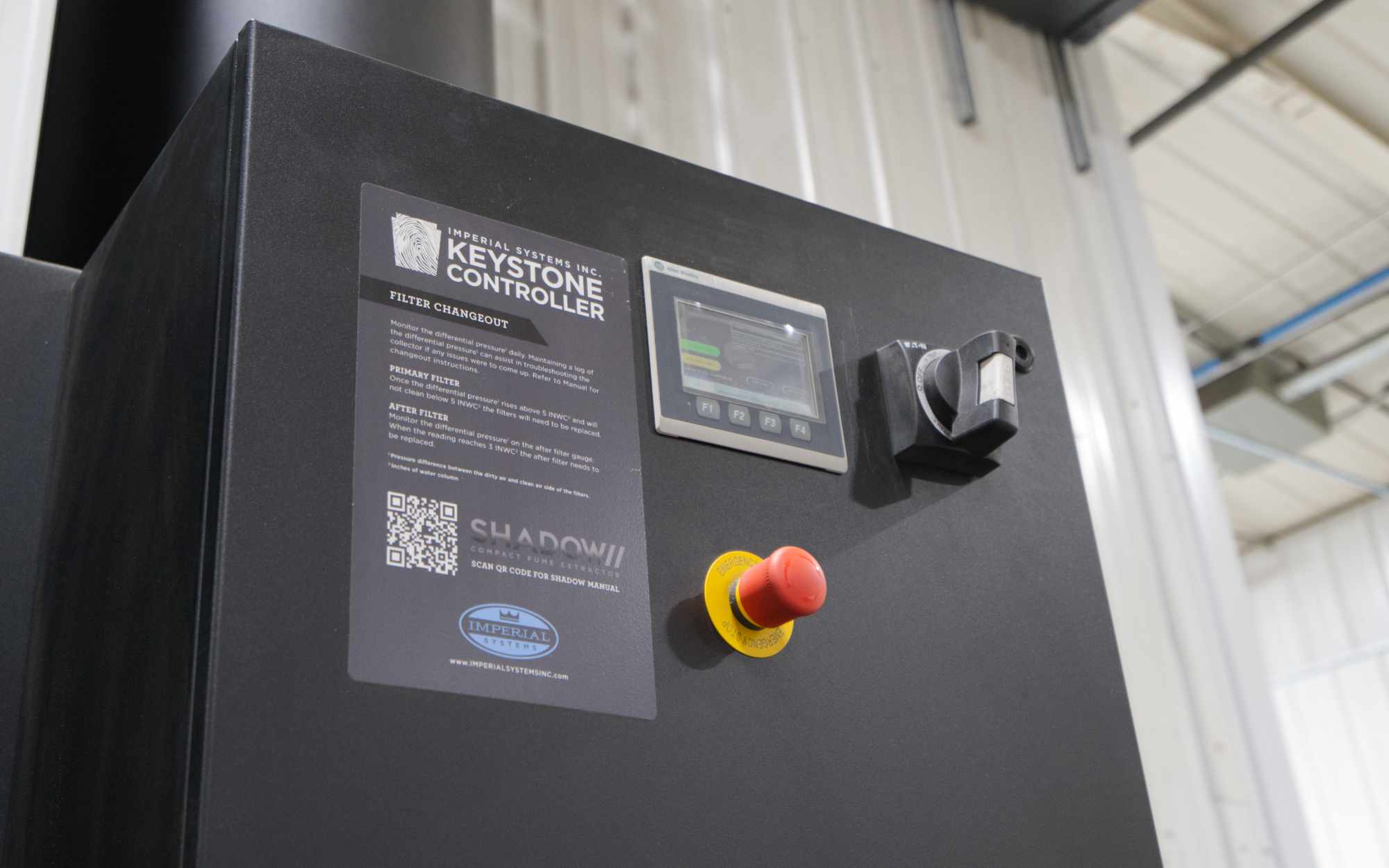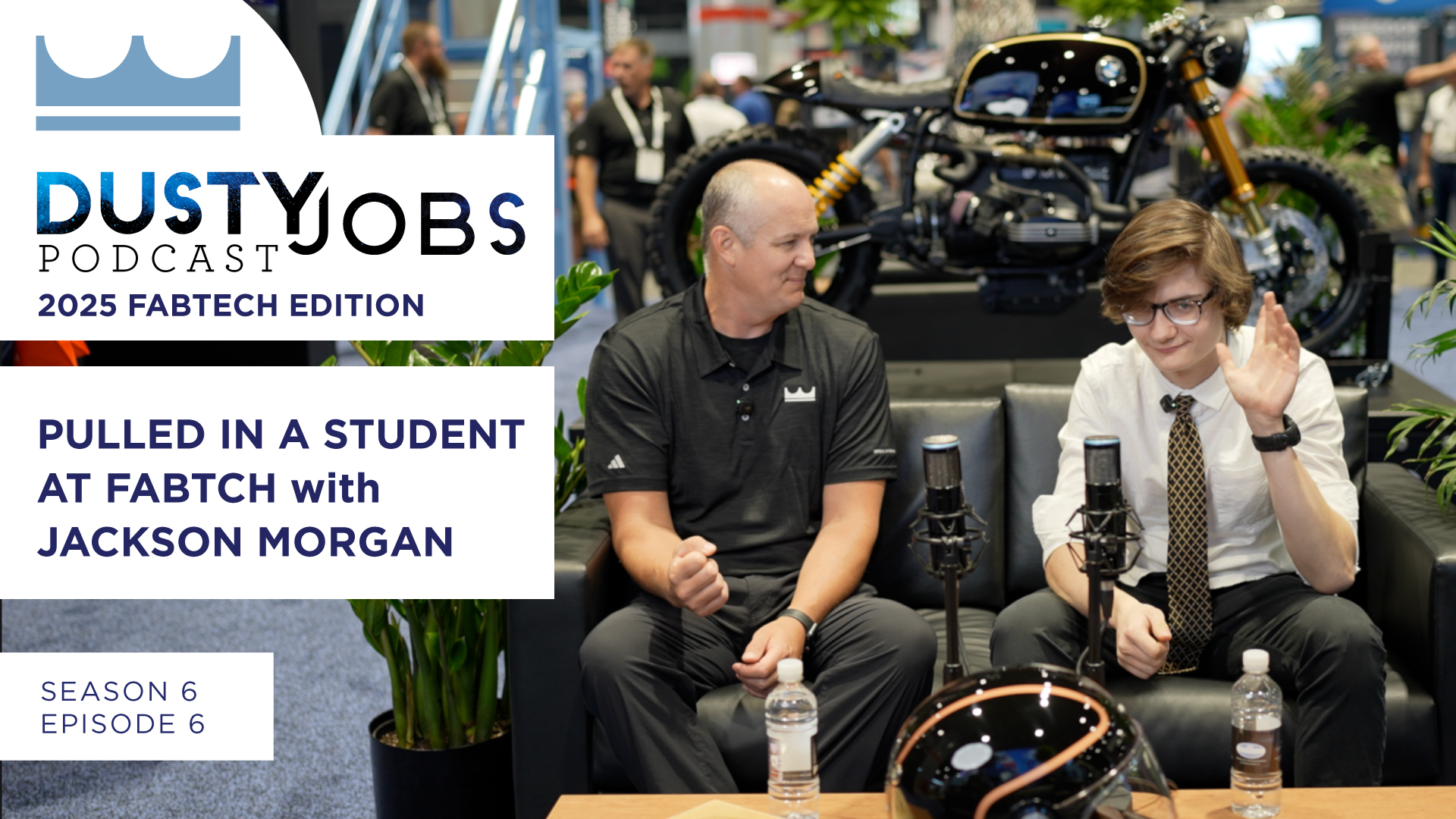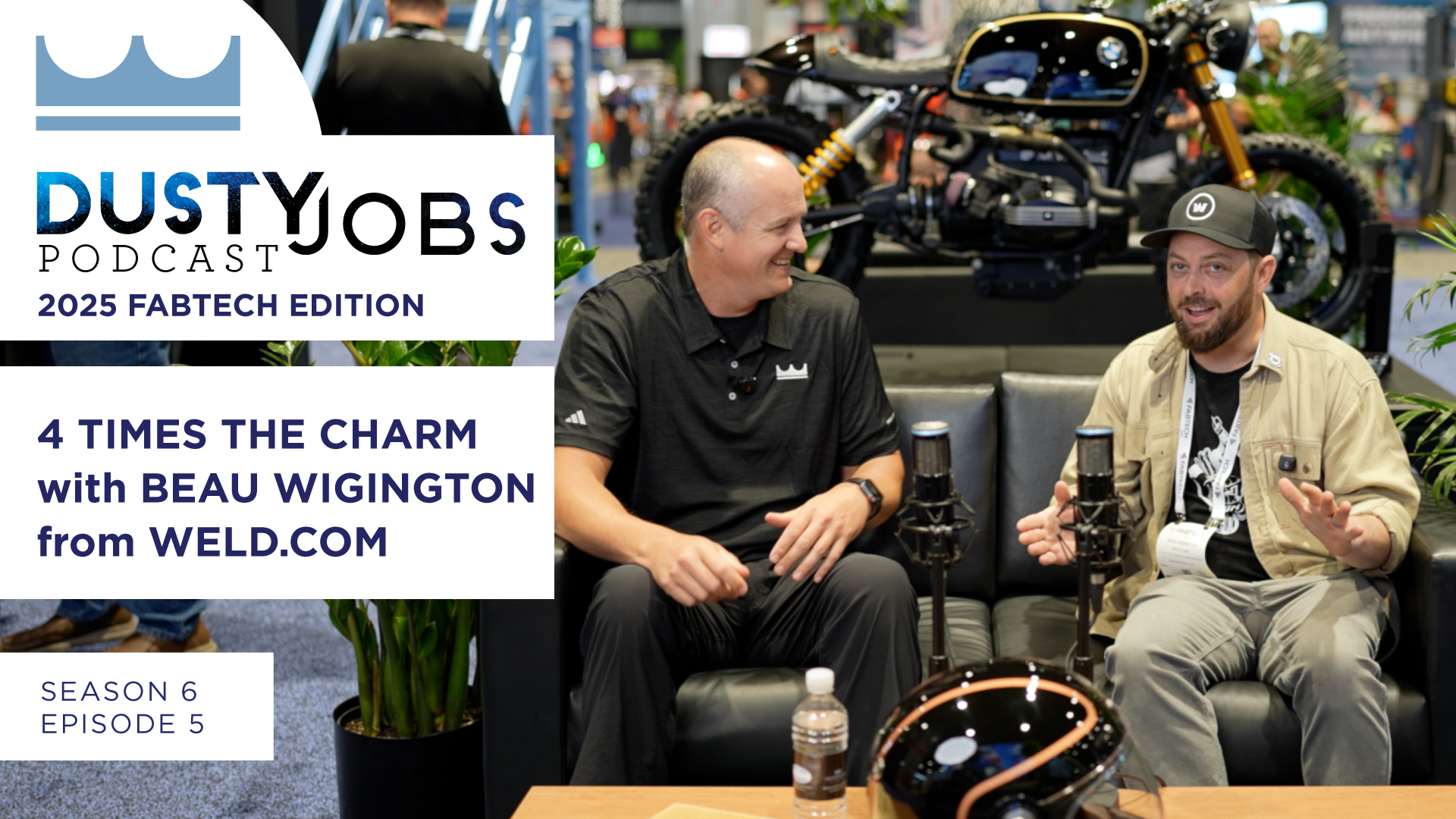In Season 6 Episode 2 of the Dusty Jobs Podcast, Donovan sits down with Chris Cloney, founder of Dust Safety Science, at the International Powder and Bulk Solids Show. Chris Cloney discusses the new initiatives, including the Combustible Dust Training Institute (CDTI), which will offer training and certification programs in dust explosion safety. CDTI’s mission is to advance effective, efficient, and compliant combustible dust safety by creating comprehensive training and certification programs that empower individuals working in industries that handle combustible dust around the world.
Narrator: Welcome to the Dusty Jobs podcast from Imperial Systems. Industry knowledge to make your job easier and safer.
Donovan: Hello, welcome to another episode of the Dusty Jobs podcast. We got Chris back with us. How’s it going, Chris?
Chris: Doing awesome. I’m very excited.
Donovan: Yeah, so Chris, you’ve been, this is not your first time on our podcast. You’ve been here before. This is your, I think it’s your third episode with us.
Chris: Sounds right.
Donovan: Yeah.
Chris: Second time live at the Powder Show.
Donovan: At the Powder Show. Which is like, it’s great. I mean, with a lot of people this year, it seems like a really good show.
Chris: Yep.
Donovan: A lot of good stuff is going on. And you guys, you’re not just here talking this year. You actually have a booth this year, don’t you?
Chris: We do, yes. Our first time on this side of the table, I guess.
Donovan: Yeah.
Chris: We’ve presented a ton and presented this year, but we have an exhibition booth as well.
Donovan: Yeah, yeah. So you’re here with Dust Safety Science.
Chris: Yep.
Donovan: And you guys, so anybody who’s not familiar with what Dust Safety Science is, could you fill us in on a little bit more of what you guys do?
Chris: DustSafetyScience.com. We’re a connection platform for generating awareness for combustible dust safety, as well as connecting folks with experienced companies like yourselves. So, looking for dust collection systems, looking for vacuum systems, looking for people that provide dust hazard analysis services, explosion protection items. They got a problem with combustible dust. Dust Safety Science has a resource for them to come and actually learn about the problem, but then find folks like yourselves to work with.
Donovan: Yeah, and I know I’ve reached out to you in the past, even when I have some questions on things.
Chris: Sure have.
Donovan: And you find some people who, like, I mean, I don’t even know. There’s people who knew this stuff, but it’s great. You guys usually always come through and help find out, like, exactly what I need to know.
Chris: We get the tricky stuff, right? So, I say I don’t know the answers to everything, but we generally know who to ask. So, we call it our help desk. We, this, literally, on my phone right now, I have the list of tickets that are open. One of them is, you know, isolating munitions and pyrotechnics from explosions. There’s another one on, there’s several on metal dust and challenges with inerting or ignition sensitivity.
Donovan: Yeah.
Chris: So, yeah, when there’s a question people don’t know how to get an answer to, reach out there and help desk kind of get some sort of…
Donovan: I remember I emailed you one that was quite odd. It was, how much lime does it take to make this certain dust and dirt? And we figured it out. We, like, somehow, we found a person who had the formula and got the answer.
Chris: Unfortunately, it’s a lot. It is a lot. But, yes, we did get an answer.
Donovan: Yeah. Yeah. It kind of made it not a possibility to do that that way.
Chris: It’s not easy for me, but you can do the calculation.
Donovan: You can. You can.
Chris: Yeah.
Donovan: So, but…So that’s what, that is currently what the history of Dust Safety Science has been. And now, what, I mean, you guys are here, you’re presented. What’s new? What’s new with you guys?
Chris: So, one of the reasons we’re exhibiting is we have recently launched the Combustible Dust Training Institute.
Donovan: So, wait, wait, say that again. The Combustible Dust Training Institute. Okay, I’m with you.
Chris: CDTI.
Donovan: Okay.
Chris: The mission with Dust Safety Science was always to have at least one year with zero fatalities worldwide by 2038. Started in 2018. So, those that are counting were seven years in and we got, what, 13 years left?
Donovan: Yeah. Yeah. And I think we’re getting better every year.
Chris: Yeah.
Donovan: I don’t know if we’re there yet, but it’s definitely…
Chris: We are not.
Donovan: We’re getting safer, though. We’re definitely getting safer.
Chris: Quantitatively speaking, we haven’t hit a year with zero fatalities worldwide.
Donovan: Yeah.
Chris: But I think the awareness is getting better. There’s a lot of activity here in the US, but also globally, South America, Asia, Europe. So, that’s been coming along well. And our role in that has been connection platform, education, awareness through Dust Safety Science. One of the challenges was there’s no real pipeline for people to understand this stuff.
Donovan: Yeah.
Chris: Not necessarily the really detailed questions like you or other centers that help us.
Donovan: Right.
Chris: Just basic, what are combustible hazards? How do you assess them? What’s the right way to do dust collection system design installation? What’s combustible dust testing? What does that look like? What scenarios do we need to do more than the basic set of testing?
Donovan: Like the 101s.
Chris: Yeah. 101s and maybe 201s as well.
Donovan: Right.
Chris: It doesn’t exist. And so, that’s the goal for CDTIs to fill that void of having training programs for people to go through this stuff. All the way from basic, if you want to do testing, having an online on-demand program for understanding the combustible dust testing. Then we’re working all the way up to actually having certifications for being a certified dust safety professional or being a certified DHA leader. And those programs are bigger.
Donovan: Right.
Chris: 6-month, 12-month programs to get a real deep dive in knowledge in this sort of stuff. Also, exposure and experience in the industry so that when you come out with finishing that training, you actually know what you’re talking about. You know what you’re talking about anyway.
Donovan: Yeah. Yeah. But there is a lot of people who are coming straight out of college that are engineers. And they might be going into a facility, being a facilities engineer. And they get tasked with, you know, now you have this dust collector project. And they might have never learned at all about that the whole way through their college career. And these are educated people. They’re smart people. But that’s just an area they’ve never been exposed to. And you’re right. There’s not just a good resource as of right now to go, until now, to go and start to learn these basic things to educate yourself enough to make the right decision for the health and the safety of the people that are dependent on you to design something correctly.
Chris: Yeah. And there’s that side of the equation, just the, I’d say, junior staff and companies knowing, you know, knowing how to work through. We, because we run a help desk probably at least once a month, if not more, we get a call from consultants saying, “Do you know who we can hire? We’re looking to expand.” We get a call from equipment manufacturers saying, “Hey, we want young talent to know something about combustible dust.” Or, “We just hired junior staff and we want to train them up.”
Donovan: It’s not something your guidance counselor in high school said, “Hey, you know, there’s a career in exploding dust.”
Chris: And so there’s just no, and come on that with, we have a lot of older people that are kind of retiring out of combustible dust. There’s no pipeline of people. So that’s one of the founding things we’re trying to solve with CDTIs. Okay, how do we have a structured program? Maybe it’ll be a university set of course someday where we’ll work towards it. But let’s start with something where folks need to be trained up from knowing nothing to actually be able to go out and support these industries.
Donovan: Even basic vocabulary at time can be challenging at first. What is KSt? What is PMAX? How does that work? What are those means? How do I evaluate this? Not even knowing the vocabulary within this space can set its own set of challenges when someone’s reading a spec or someone’s trying to write a spec to get a bit out. So is that some of the stuff you guys are covering in this?
Chris: It is.
Donovan: When I’m looking at the 101 courses, walk me through a couple of what those are.
Chris: Yeah, so great question. The starting point is we have a certificate program, combustible specialist certificate. That’s a 10 hour on-demand course. We’ve had 80 people go through it so far. And most have finished it now and done the quizzes and got their certificate. So that’s sort of like the step one version.
Donovan: So if I would go into that, what would be some of the basic things I’d learn about?
Chris: So you cover it at a high level combustible dust testing, so identification hazards, the DHA process, so you understand how it works, not necessarily you can go and complete it yourself.
Donovan: So if I had that combustible dust test back, I’d actually read it and know what I’m talking about a little bit.
Chris: Interpretation of data is in there. Then high level on protection methods, prevention methods. It’s sort of, it’s not, we don’t have an awareness course, like a two hour, be aware, this is sort of, I’d say this is 101 level. We will have an awareness course because we haven’t created it yet. So this is enough to bring somebody up to speed, probably geared towards like equipment manufacturer where they want to be able to talk sensibly with their clients about this sort of thing.
Donovan: Right.
Chris: And know what they don’t know. So that’s the certificate program. Then we have a number of core courses within a curriculum that we’re developing. So a much deeper dive on testing, a much deeper dive on hazard prevention and mitigation systems, interpretation results from dust hazard analysis, management systems, like housekeeping, management of change, that sort of thing. And a couple other programs that we’re building out. And if you combine that with this certificate, that’s what the certification is that we’re building towards.
Donovan: Gotcha.
Chris: So to get that certification, then you do all the core course requirements. You have some electives you can specialize in. There is an exam at the end of the six month period. It’s not small, 200 multiple choice questions.
Donovan: Holy moly.
Chris: But it’s not meant to be a walk in the park. It’s also not meant to take six days to get through. And that’s some experience, experiential learning requirements on the job stuff. And that gets you through that certification.
Donovan: So what would be some of those experiential learning?
Chris: There’s two kind of flavors. If you’re working in a job where you’re actively handling the bustle dust on a day to day basis, that’s probably going to be able to fill those requirements.
Donovan: So if I’m in a Powder & Bulk situation such as a wood factory or a grain facility, probably just interacting with what’s going on there would handle that?
Chris: A lot of the time we’re still working through the committee to be able to evaluate experiential learning and what works and what doesn’t.
Donovan: Yeah.
Chris: But generally, if you’re working with the dust collection company, you have jobs where you’re specifying equipment, that’s a really good experiential learning opportunity. If you’re a health and safety manager and you’re taking the program and you have some combustible dust on site, but you’re taking it just, you know, you’ve had your DHA done by an outside expert and you’re not really involved with projects, we submit projects for those folks, we provide learning opportunities for them. There might be a case study of an incident that happened. You have to back rewrite what a DHA might look like for it.
Donovan: Gotcha.
Chris: There’s a case where if you can’t get that learning experience on your day-to-day job, then we’re providing those learning opportunities for folks. Because we want to be able to do both. We want you guys, we want equipment providers to be able to go through the program, get value, but also then health and safety folks, occupational health and safety, industrial hygiene, so they can step in and be that SME, that subject matter expert for their company to interface with folks that are helping them.
Donovan: So if somebody’s out there and they’re looking on the internet right now and they’re trying to find, they got tasked with the first time their company is going to be dealing with a combustible dust situation.
Chris: Yeah.
Donovan: By the end of this six-month course, they’d probably be pretty well set to be able to evaluate anything that’s coming in, how to actually look at the products that they need to purchase, how to talk to the equipment providers about,
Chris: Right
Donovan: I mean that’s the goal of it?
Chris: It is. Yeah. There’s two programs, there’s a certified DHA leader and then there’s a certified dust safety professional program. That kind of flavors kind of towards the certified dust safety professional.
Donovan: Gotcha.
Chris: There is a DHA leader program as well, which is a bit different. But the certified dust safety professional, it’s really about interfacing better. So when you get quotes for a bunch of exposure protection equipment, you know enough to be able to assess, is this the right protection, does this make sense?
Donovan: How to ask the right questions.
Chris: Yeah. You know, who do I go to if I need to understand the dust collection system. We need to do grounding and bonding. Like, it’s more about being that subject matter expert point of contact within your company, so you at least have somebody that can do that.
Donovan: Right.
Chris: The DHA leader program also has some elements on top of that about how to lead and facilitate the hazard analysis process. How to build a team. Who to look for to bring into that team. How to actually run site assessment. How to do the reporting afterwards.
Donovan: Yeah.
Chris: That’s kind of where you get in with. If you do a CDSP program, you shouldn’t really be set into the wild to start doing hazard analysis and hazard assessments yourself. There’s more training and experience and requirements on top of that.
Donovan: But if you did the, what was the first one?
Chris: CDSP.
Donovan: You probably would have a better understanding on how to read your dust hazard analysis.
Chris: Exactly.
Donovan: When you have someone bring it back to you.
Chris: Yeah, exactly. And it’s a big challenge. Like, people go get a DHA done today. Some DHA providers are better at this than others. Some will walk through and help them understand. But others just get the paper and they don’t know what to do with it.
Donovan: Right.
Chris: So if you’re a certified dust safety professional, our hope is that you’ll know what to do with that when you start actually making your facility safe.
Donovan: Yeah, because that’s the whole goal of the DHA is that in the end, you have a safer facility.
Chris: That is the goal.
Donovan: That’s the goal. So that people can go home to their families the way they came to work.
Chris: And we can get closer to our mission of one year zero fatalities worldwide.
Donovan: Yeah.
Chris: Because we can’t if the facility doesn’t actually get safer at the end of the day.
Donovan: Right. Right. And there’s, like you said, I think there’s a lot of people out there that might not even know at this point that they’re dealing in a facility that’s not 100% up to where it should be.
Chris: So we have three levels on what we kind of explained through. We’re trying to make facilities compliant. Well, try to help facilities implement compliant, effective and efficient combustible dust safety programs.
Donovan: Yeah.
Chris: So step one is, okay, how do we get to compliance?
Donovan: Right.
Chris: Step two is, is it actually effective? So there are some areas, you know, if you have a really simple facility, compliance might keep everyone safe.
Donovan: Right.
Chris: You have a more complex facility. Okay, compliance. What do we need to do on top of that to actually have an effective safety program? And then efficient. How do we have an efficient safety program? So are we spending our safety dollars wisely? Are we getting a good return on our safety dollars spent?
Donovan: Yeah.
Chris: Are we over protecting here where if we did a risk assessment, maybe we were able to take that protection scheme, that base of safety, and go with something that’s not over protected and spend that money elsewhere in terms of safety programs training, whatever.
Donovan: Because if it’s not all of those things, then it might end up failing in the end.
Chris: Yeah.
Donovan: People won’t stay with it. People won’t do it.
Chris: Yeah. We call them mature. Like, I’m thinking of a really mature safety system or organization has really mature safety. They have all those elements, right? They’re in compliance.
Donovan: Right.
Chris: They have an efficient safety program. It actually stops you from getting hurt.
Donovan: Right.
Chris: And they have an, or that’s effective. And they have an efficient safety program. They’re being wise with how they’re investing their safety dollars every day. That’s what good looks like. I’m sure you’ve seen various phases of that.
Donovan: I have. I’ve seen good to nothing.
Chris: Yeah. So, you can be any, and we’re just trying to, okay, here’s how you build up that compliance, effective, efficient. And if you skip the step, if you try to do efficient before you are effective or compliant, it doesn’t, a lot of people try to go to that route. It doesn’t work all that well. Same thing if you try to, you know, if you try to make it effective, but say, yeah, we know better than the NFPA 664. So, we’re going to do it this way. And you just guess and leave some stuff out and you’re not in compliance. Maybe you can do that, but in a lot of cases, you’re only leaving out because you haven’t experienced a loss that has driven the change in the requirement that came in the first place.
Donovan: Right.
Chris: So, it’s advisable to start with compliance, then move to effective, and then make it efficient after that.
Donovan: Yeah. Yeah. That’s a great model for making it for you.
Chris: I’ll be presenting that next year at Powder and Bulk Solids. I don’t know yet, but maybe I’ll pitch it to them.
Donovan: So, but, okay, so if someone’s interested in signing up for one of these classes, being part of that, how do they do that? How should they reach out? I mean, do you just Google this or what’s the best way to do it?
Chris: The best way is just to go to dustsafetyscience.com, and you’ll see there’ll be a button or tab somewhere that’s training.
Donovan: Okay.
Chris: Eventually, it’ll be more prominent on the site if it’s not already. And that’s the best way. You can always reach out to me, Chris, at dustsafetyscience.com. We run our own podcast.
Donovan: Yeah, you guys are going to respond to information on there.
Chris: And if you’ve got a question, like, training side, do you want training? Do that.
Donovan: Yeah.
Chris: If you’ve got a question, you’re stuck, you can’t figure something else out, just do the same thing. Go to dustsafetyscience.com and ask us. We don’t know the answer. Chances are we know the person that does.
Donovan: You know a guy.
Chris: And if we don’t, then chances are we don’t have an answer. You might need to ask a better question. We’ll work on it.
Donovan: Yeah. So, are you looking at me, Chris, so I need to ask better questions when I send them to you? No, it’s all right.
Chris: There’s a distribution of users for our help desk from little to lots and Donovan is on the other side of the curve. So you have to use it quite a bit, which is good. We appreciate it.
Donovan: Yeah. So, yeah, I appreciate it too because usually I only get these questions when I come to you when people are trying to make their facilities better and safer. And so if I had to come to you with something, Chris, I always, for me, it’s great because people aren’t just ignoring issues anymore. And we’re actually asking hard questions as opposed to just kicking that can down the road to where, well, we’ll just wait and see what happens. And I don’t think that’s really a good answer.
Chris: I agree.
Donovan: Yeah.
Chris: Thanks for having me on. So I look forward two more years to do another one of the next steps.
Donovan: Yeah, there you go. There you go. So, hey, thanks for everybody for listening. Check out Chris at Dust Safety Science and check us out on YouTube, Instagram, all those social media feeds, like and subscribe. And until next time, stay healthy and stay safe.
Chris: See you.
Narrator: Thanks for listening to the Dusty Jobs podcast. Breathe Better. Work safer.




